Potret Arab Saudi di Masa Datang : Menghilangkan Jejak Rasulullah?
Potret Arab Saudi di Masa Datang : Menghilangkan Jejak Rasulullah?
SUMBER TULISAN: SwaraMuslim
Arab Saudi, seperti juga negara-negara lain yang bergelimang harta, terus melakukan modernisasi. Selain secara pemikiran, seperti diangkatnya seorang perempuan dalam jajaran kementrian di negara itu, juga pembangunan fisik pun dilakukan. Tetapi, pengembangan Arab Saudi, khususnya kota suci Makkah dan Madinah akhir-akhir ini tidak memedulikan situs-situs sejarah Islam.
Makin habis saja bangunan yang menjadi saksi sejarah Rasulullah SAW dan sahabatnya.
Bangunan-bangunan itu dibongkar karena berbagai alasan, namun sebagian besar karena ingin menyesuaikan dengan kota-kota besar di dunia lainnya. Bahkan sekarang, tempat kelahiran Nabi SAW terancam akan dibongkar untuk perluasan tempat parkir.
Sebelumnya, rumah Rasulullah pun sudah lebih dulu digusur. Padahal, disitulah Rasulullah berulang-ulang menerima wahyu. Di tempat itu juga putra-putrinya dilahirkan serta Khadijah meninggal.
Beberapa bulan yang lalu, Sami Angawi, pakar arsitektur Islam di wilayah Arab mengatakan bahwa beberapa bangunan dari era Islam kuno terancam musnah. Pada lokasi bangunan berumur 1.400 tahun Itu akan dibangun jalan menuju menara tinggi yang menjadi tujuan ziarah jamaah haji dan umrah.
Jamarat Project – dalam tahap penyelesaian
“Saat ini kita tengah menyaksikan saat-saat terakhir sejarah Makkah. Bagian bersejarahnya akan segera diratakan untuk dibangun tempat parkir,” katanya kepada Reuters. Angawi menyebut setidaknya 300 bangunan bersejarah di Makkah dan Madinah dimusnahkan selama 50 tahun terakhir.
Bahkan sebagian besar bangunan bersejarah Islam telah punah semenjak Arab Saudi berdiri pada 1932. Hal tersebut berhubungan dengan maklumat yang dikeluarkan Dewan Keagamaan Senior Kerajaan pada tahun 1994.Nasib situs bersejarah Islam di Arab Saudi memang sangat menyedihkan. Mereka banyak menghancurkan peninggalan-peninggalan Islam sejak masa Ar-Rasul SAW.
Semua jejak jerih payah Rasulullah itu habis oleh modernisasi. Sebaliknya mereka malah mendatangkan para arkeolog (ahli purbakala) dari seluruh dunia dengan biaya ratusan juta dollar untuk menggali peninggalan-peninggalan sebelum Islam baik yang dari kaum jahiliyah maupun sebelumnya dengan dalih obyek wisata.
Kemudian dengan bangga mereka menunjukkan bahwa zaman pra Islam telah menunjukkan kemajuan yang luar biasa, tidak diragukan lagi ini merupakan pelenyapan bukti sejarah yang akan menimbulkan suatu keraguan di kemudian hari. Wallohu alam bi shawab. (sa/skpc/erm)
Tahukah anda? Makkah sekarang sudah seperti Las Vegas
“Makkah sekarang sudah seperti Las Vegas, ” begitulah pernyataan yang dilontarkan Ali al-Ahmad, direktur Institute for Gulf Affairs-lembaga riset oposisi Saudi- yang berbasis di Washington, melihat perkembangan kota suci Makkah saat ini.
Kota Makkah yang menyandang sebutan kota suci dan menjadi pusat ibadah haji umat Islam di seluruh dunia, ketenangan dan kekhusyuk-annya makin terkikis, Ka’bah yang terletak di tengah masjid Haram dan menjadi arah sholat Muslim sedunia, semakin tenggelam oleh berdirinya gedung-gedung tinggi.
Menurutnya, perkembangan kota Makkah sekarang adalah sebuah bencana. “Hal ini akan memberikan pengaruh buruk bagi umat Islam. Ketika mereka ke Makkah mereka tidak punya perasaan apapun, tidak ada keunikan lagi. Apa yang anda lihat cuma semen dan kaca, ” ujar Ahmad serius.
Ahmad cukup beralasan melontarkan pernyataannya itu, karena kota Makkah saat ini makin penuh dengan bangunan-bangunan tinggi mulai dari hotel, pusat perbelanjaan dan toko-toko besar yang menjual produk Barat. Sebut saja kedai kopi Starbucks, Cartier and Tiffany, H&M dan Topshop.
Pusat perbelanjaan Abraj Al-Bait ( www.abrajalbait.com ), salah satu mall terbesar di Saudi yang baru dibuka menjelang musim haji bulan Desember 2006 kemarin, nampak megah dengan monitor-monitor televisi flat, cahaya lampu-lampu neon, dengan pusat hiburan, resto-resto cepat saji, bahkan toko pakaian dalam.
Pusat perbelanjaan itu, nantinya juga akan dilengkapi dengan kompleks hotel yang menjulang tinggi. Bahkan kompleks bangunan yang rencananya selesai tahun 2009 nanti, akan menjadi gedung tertinggi ketujuh di seluruh dunia, dilengkapi dengan fasilitas rumah sakit dan tempat sholat yang luas.
Seluruh pegunungan di dekat Jabal Omar, kini sudah diratakan. Di lokasi itu juga akan dibangun kompleks hotel dan lebih dari 130 gedung-gedung tinggi baru.
Kota Makkah yang menyandang sebutan kota suci dan menjadi pusat ibadah haji umat Islam di seluruh dunia, ketenangan dan kekhusyuk-annya makin terkikis, Ka’bah yang terletak di tengah masjid Haram dan menjadi arah sholat Muslim sedunia, semakin tenggelam oleh berdirinya gedung-gedung tinggi.
“Ini adalah akhir dari Makkah, ” kata Irfan Ahmad dari London, pendiri Islamic Heritage Foundation, yang secara khusus aktivitasnya mempertahankan peninggalan-peninggalan bersejarah di Makkah, Madinah dan tempat-tempat lainnya di Arab Saudi.
“Sebelumnya, bahkan pada masa Ustmani, tak satu pun gedung-gedung di Makkah yang tingginya melebihi tinggi Masjid Haram. Sekarang, banyak gedung yang lebih tinggi dari Masjid Haram dan tidak menghormati keberadaan masjid itu, ” tukas Irfan.
Uang, tentu saja menjadi motivasi utama boomingnya gedung-gedung tinggi di Makkah. Karena setiap tahun, kota itu dibanjiri oleh para jamaah haji. Papan-papan iklan di sepanjang jalan menuju Makkah, seolah menjadi daya tarik bagi para investor yang mencari keuntungan dari usaha penginapan.
Sejumlah organisasi Islam mengatakan, berdirinya gedung-gedung megah di kota Makkah, juga dilatarbelakangi motif agama. Mereka menuding pemerintah Saudi mengizinkan kelompok konservatif untuk menghancurkan tempat-tempat bersejarah dengan alasan khawatir tempat itu justeru disembah-sembah oleh para pengunjung.
Ahmad dari Islamic Heritage Foundation mengaku punya kalatog lebih dari 300 tempat-tempat bersejarah di Arab Saudi, termasuk pemakaman dan masjid-masjid. Ia mengatakan, sebuah rumah tempat Nabi Muhammad dilahirkan dihancurkan untuk membangun tempat kamar mandi.
“Sama sekali tidak menghormati Kabah, tidak menghormati rumah Tuhan atau lingkungan dari tempat-tempat bersejarah itu, ” kata Sami Angawi, seorang arsitek Saudi yang ingin mempertahankan peninggalan bersejarah di Makkah.
“Padahal, memotong pohon saja seharusnya tidak boleh dilakukan di kota ini, ” sambungnya.
Kemajuan kadang memang harus dibayar mahal. Bahkan pasar malam, di mana para jamaah bisa menjual barang-barang yang dibawanya, kini sudah tidak ada lagi. Begitu juga dengan keluarga-keluarga di Makkah yang biasa menyambut para jamaah haji, sudah tidak terlihat lagi sejak rumah-rumah mereka digusur untuk perluasan Masjid Haram di era tahun 1970-an.
Angawi kini berusaha melakukan pendekatan pada kerajaan Arab Saudi agar memberi perhatian besar atas penghancuran tempat-tempat bersejarah. Ahmad melobi pemerintah-pemerintah negara Asia dan Arab untuk menghentikan penghancuran yang dilakukan pemerintah Saudi. Kedua tokoh ini menyayangkan kurangnya kepedulian umat Islam atas isu-isu ini. Kepentingan bisnis dan uang mengalahkan segala-galanya.
“Makkah tidak pernah berubah seperti sekarang ini. Apa yang anda lihat sekarang baru 10 persennya saja dari apa yang akan ada, yang akan jauh lebih, lebih buruk lagi, ” kata Angawi risau. (ln/IHT/eramuslim)
FOTO -FOTO TEMPAT BERSEJARAH YANG DI MUSNAHKAN WAHHABI-SALAFY
 Sisa reruntuhan kamar Rasul Saw dan Sayyidah Khadijah ra.
Sisa reruntuhan kamar Rasul Saw dan Sayyidah Khadijah ra.
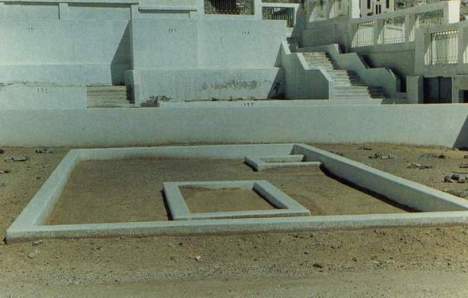 kuburan Sayyidah Khadijah al-kubra dan putranya Qasim di pojok
kuburan Sayyidah Khadijah al-kubra dan putranya Qasim di pojok
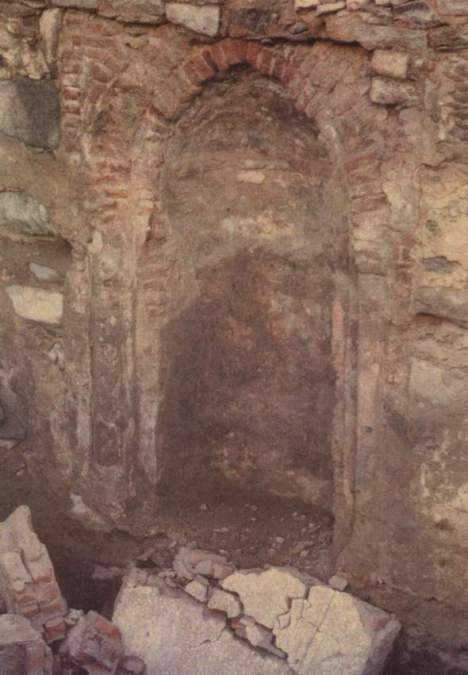 Mihrab tempat Rasulullah saw. biasa shalat di rumah Khadijah ra
Mihrab tempat Rasulullah saw. biasa shalat di rumah Khadijah ra
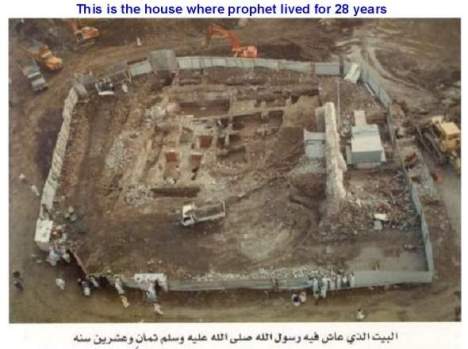 Rumah Nabi Saw dan Sayyidah Khadijah ra tempat mereka berdua tinggal selama28 tahunpun dibongkar
Rumah Nabi Saw dan Sayyidah Khadijah ra tempat mereka berdua tinggal selama28 tahunpun dibongkar
Reruntuhan tempat ketika Sayyidah Fathimah Az-Zahra as. Puteri kesayangan Rasulullah saw. dilahirkan
___________________________________________________________________
The Destruction of Holy Sites in Mecca and Medina
By Irfan Ahmed
Source: http://www.almusaffir.com/modules/myalbum/photo.php?lid=337&cid=7
The Arabian Peninsula, the cradle of Islam, is being demolished by hardliners. In countries such as Saudi Arabia almost all of the Islamic historical sites are gone, but this is not the first time they have been destroyed.
In 1802, and army led by the sons of Muhammad ibn ‘Abd al-Wahhab (the founder of Wahhabism) and Muhammad ibn Saud occupied Taif and began a bloody massacre. A year later, the forces occupied the holy city of Mecca. They executed a campaign of destruction in many sacred places and leveled all the existing domes, even those built over the well of Zamzam. However, after the army left, Sharif Ghalib breached the truce, inciting the Wahhabis to reoccupy Mecca in 1805.
In 1806, the Wahhabi army occupied Medina. They did not leave any religious building, including mosques, without demolishing it, whether inside or outside the Baqi’ (graveyard). They intended to demolish the grave of the Prophet Muhammad, may the peace and blessings of God be upon him, many times, but would repeatedly change their minds. At this time, non-Wahhabi Muslims were prevented from performing the Hajj (pilgrimage). In 1805, Iraqi and Iranian Muslims were refused permission to perform Hajj, as were the Syrians in 1806 and Egyptians the following year. The Saudi leader at the time wanted the pilgrims to embrace his Wahhabi beliefs and accept his Wahhabi mission. If they refused, he denied them permission to perform the Hajj and considered them heretics and infidels—ignoring the word of God in Sura al-Baqara:
And who is more unjust than he who forbids that in places for the worship of God, His name should be celebrated? Whose
zeal is (in fact) to ruin them? It was not fitting that such
should themselves enter them except in fear. For them there
is nothing but disgrace in this world, and the world to come,
an exceeding torment. (Qur’an 2:114)
The Wahhabi army’s destruction campaign targeted the graves of the martyrs of Uhud, the mosque at the grave of Sayyid al-Shuhada’ Hamza bin Abdul Muttalib and the mosques outside the Baqi’: the Mosque of Fatima al-Zahra, the Mosque of al-Manaratain, and Qubbat’ al-Thanaya (the burial site of the Prophet’s incisor that was broken in the battle of Uhud). The structures in the Baqi’ were also leveled to the ground and not a single dome was left standing. This great place that was visited by millions of Muslims over many centuries became a garbage dump, such that it was not possible to recognize any grave or know whom it embraced.
The occupation of the holy places by the army and their preventing Muslims from performing Hajj led thousands of people to flee Mecca and Medina to escape religious persecution. The Muslims started to complain and express their concerns, and public opinion put pressure on the Ottoman Caliph to liberate and rebuild the two holy places and once again permit the Muslims to perform the pilgrimage. Accordingly, an army led by Muhammad Ali Pasha, the Caliph’s viceroy in Egypt, was sent. When the forces arrived in the Hijaz, a number of tribes marched in support of the army, which regained control over Medina and then Mecca.
In 1818, the Wahhabis were defeated and they withdrew from the holy places. The Prophet’s Mosque, the Baqi’ and the monuments at Uhud were rebuilt during the reigns of the Ottoman sultans ‘Abd al-Majid I, ‘Abd al-Hamid II and Mahmud II. From 1848 to 1860, the buildings were renovated and the Ottomans built the domes and mosques in splendid aesthetic style. They also rebuilt the Baqi’ with a large dome over the graves of the Prophet’s daughter Fatima al-Zahra, Imam Zainul ‘Abidin (‘Ali bin al-Hussain), Imam Muhammad ibn ‘Ali al-Baqir and Imam Ja‘far al-Sadiq. The graves of others related to the Prophet found at the Baqi’ include those belonging to Ibrahim (son), ‘Uthman ibn ‘Affan (Companion and son-in-law), Saffia bint Abdul Muttalib (aunt), Atika bint ‘Abd al-Muttalib (aunt), Al-‘Abbas ibn ‘Abd al-Muttalib (uncle), Fatima bint Assad (Imam Ali’s mother), ‘Abd Allah ibn Ja‘far bin Abi Talib (cousin) and Aqil ibn Abi Talib (The Prophet’s cousin).
The grave of the Prophet’s father ‘Abd Allah was in Dar al-Nabigha of the Bani Najjar, the house of where the Prophet learned to swim. However, his father’s grave was exhumed 17 years ago and transferred to the Baqi’. The area of the house today lies under the marble covering the plaza surrounding the mosque.
A number of the Prophet’s wives (the Mothers of the Faithful) were buried in the Baqi’: ‘A’isha, Hafsa, Juwayriya, Saffia, Sawda, Zaynab bint Khuzaima, Zaynab bint Jahsh, Umm Habiba and Umm Salama. The tomb of Khadija, the Prophet’s first wife, is in Mecca because she died before the Hijra (migration of Muslims to Medina). Her grave is in the Hajun cemetery, known as Maqbarat’al-Ma’la. The tomb of Maimouna, another wife, is also in Mecca in an area known as Sarif, which lies on the side of the Hijra Road, nearly 13 miles (20 kilometers) outside Mecca.\
On April 21,1925, the domes in the Baqi’ were demolished once more along with the tombs of the holy personalities in Maqbarat’al-Ma‘la in Mecca, where the Holy Prophet’s mother, wife Khadija, grandfather and other ancestors are buried. Destruction of the sacred sites in the Hijaz continues till this day. Wahhabis say they are trying to rescue Islam from what they consider innovations, deviances and idolatries. Among the practices they believe are contrary to Islam are constructing elaborate monuments over graves and making supplications there.
The Mashrubat Umm Ibrahim—which was built to mark the location of the house where the Prophet’s son, Ibrahim, was born to Mariah, his Egyptian wife—also contained the grave of Hamida al-Barbariyya, the mother of Imam Musa al-Kazim. These sites were destroyed over the past few years.
I recently met with one of the leading political leaders of Medina and took the opportunity to speak to him about the destruction of these holy sites. He told me that the sites were not being demolished, but that torrential rain in Medina was washing away the old buildings! I told him the mosque and tomb of Sayyid Imam al-Uraidhi ibn Ja‘far al-Sadiq, four miles from the Prophet’s Mosque, was destroyed by dynamite and flattened on August 13, 2002. Imam al-Uraidhi is ninth in line from the Prophet. I also asked him about the plan to demolish the last remnant of the historical vestiges of the Messenger of God, namely his noble birthplace, which has been converted into a library, “Maktabat Makka al-Mukarrama.” There was no answer.
Within the last 10 years, Muqbil ibn Hadi al-Wadi’i, a student at the University of Medina, wrote a thesis titled “About the Dome Built over the Grave of the Messenger,” sponsored by Sheikh Hammad al-Ansari. In this paper, the student demands that the noble grave be brought out of the Mosque. He says the presence of the holy grave and noble dome are major innovations and that they both need to be destroyed! His thesis received very high marks. Last year, the city planning board of Medina painted the famous green dome of the Prophet’s Holy Mosque silver. After intense protests by the citizens of Medina, the board restored the dome to its original color.
In the Ottoman part of the Prophet’s Mosque, at the center of the three sections raised a bit from the ground level are three circles. The first, toward the west, corresponds to the grave of the Prophet. The next two toward the east correspond to the graves of Abu Bakr al-Siddiq and ‘Umar ibn al-Khattab. Above the circles are invocations including “Ya Allah” and “Ya Muhammad.” The latter was removed and replaced it with “Ya Majid” by adding the dot under the ‘ha of Muhammad to make it jim and two dots under the second mim of Muhammad to make it ‘ya. There are qasidas written by rulers of the Muslim world, such as Sultan ‘Abd al- Hamid. Many verses of the famous Burda of al-Busayri had also been painted over. On the Qibla side, the brass partition that is divided into three sections between two columns, the authorities have also tried to cover the famous two verses inscribed in the east from the story of al-‘Utbi as mentioned by Ibn Kathir in his Tafsir. “O best of those whose bones are buried in the deep earth, and from whose fragrance the depth and height have become sweet! May I be the ransom for a grave in which you dwell, where purity, bounty and munificence.”
If one raises his head a bit, he will see on the first section of this partition a green banner, on which the words of the Almighty are framed in yellow:
O you who believe! Raise not your voices above the voice of
the Prophet, may blessings and peace be upon him and his
family, nor speak aloud to him in talk, as you speak aloud to
one another, lest your deeds be rendered fruitless while you
perceive not. (Qur’an 49:2)
The Sacred Chamber has four exterior doors: on the south, Bab al-Tawba (The Door of Repentance), on the north, Bab al-Tahajjud (The Door of Night Prayer), on the east, Bab Fatima (the Door of Fatima), and on the west, Bab al-Nabi (The Door of the Prophet)—also known as Bab al- Wufud (The Door of Delegations). These gates have been present since the year 668 AH except for the Gate of the Night Prayer, which was installed in 729 AH. Inside there are two gates, one on either side of the triangular part of the interior compartment. All of these doors are covered by brass shelves holding Qur’ans, an attempt to prevent the public from looking inside the Sacred chamber.
The Wahhabi religious authorities are, unfortunately, on a fast track. In 1998 the grave of Amina bint Wahb, the Prophet’s mother, was bulldozed in Abwa and gasoline was poured on it. Even though thousands of petitions throughout the Muslim world were sent to Saudi Arabia, nothing stopped this action. One of my late teachers, Sheikh Sayyid Muhammad ibn ‘Alawi al-Maliki, a Meccan who was a great historian on the holy sites and inherited his knowledge from his father and forefathers who were all teachers of the holy Haram, showed me pictures of the grave of Sayyida Amina marked with a pile of stones after the destruction. The House of Khadija was excavated during the Haram extensions, then hurriedly covered over so as to obliterate any trace of it. This was the house where the Prophet received some of his first revelations and it is also where his children Umm Kulthum, Ruqqaya, Zaynab, Fatima, and Qasim were born. Dar al-Arqam, the first school in Islam where the Prophet taught has also been demolished. It was in the area of Shi’b ‘Ali near the Bab ‘Ali door opposite the king’s palace. It is now part of the extension of the Haram.
The authorities plan to demolish the house of Mawlid, where the Prophet was born. About 60 years ago, this house, which used to have a dome over it, was turned into a cattle market. Some people then worked together to transform it into a library, which it is today. It is lined with shelves of books about Mecca, most of them written by Meccans. But the library is under threat again because of the new Jabal ‘Umar project, one of the largest real estate development projects near the Grand Mosque. The birthplace of the Prophet is to make way for a car park and hotels. About 99% of real estate owners in the Jabal ‘Umar area are shareholders in this company. The owners have been provided with financial incentives, including what they used to receive as rents, combining five-star facilities under the luxurious Le Meridien banner. The Meridien Towers will allow several thousand housing units in Mecca to be available during specified periods of time, for a one-off, fixed fee, giving the towers 25 years of shared ownership in Mecca. This scheme allow outsiders, whether Muslim or not, to invest in the city; they will be allowed to buy from a range of properties that can be used, sublet, resold or given as a gift.
For the holy month of Ramadan in Mecca, authorities built a wall enclosure in the Haram for women to pray there so men will not be able to see them. However, this has also blocked women’s visibility of the Ka‘ba while they perform their prayers. The tawaf (circumambulation) for women has also been restricted to certain times. We don’t know if these changes are permanent or just for Ramadan.
In Medina, of the seven mosques at the site of the Battle of the Trench (Jabal al-Khandaq), where Sura al-Ahzab was revealed, only two remain. The others have been demolished and a Saudi bank’s cashpoint machine has been built in the area. The remaining mosques will be demolished as soon as the new mosque being constructed is ready. One of the mosques slated for destruction is Masjid Fath, the mosque and rock of victory, where the Prophet stood during the battle of the trench praying for victory. On the rock is where he received God’s promises of victory and of the conquest of Mecca.
Dr. Irfan Ahmed is Joint Chairman of the Islamic Heritage and Research Foundation, which was formed to help protect and preserve the holy sites in the Hijaz. For more information contact islamic_heritage@hotmail.com
_____________________________________________________________________________________
ARTIKEL TERKAIT
1. Shame of the House of Saud: Shadows over Mecca
2. The Destruction of Holy Sites in Mecca and Medina By Irfan Ahmed
3. Destruction of Islamic Architectural Heritage in Saudi Arabia: A Wake-up Call By Saeed Shehabi

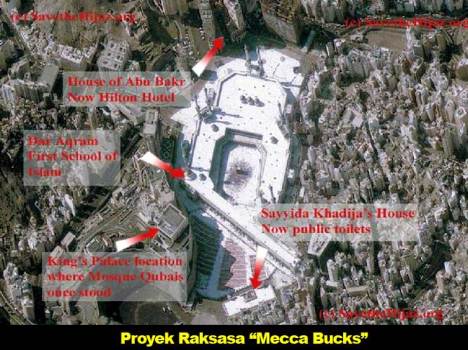



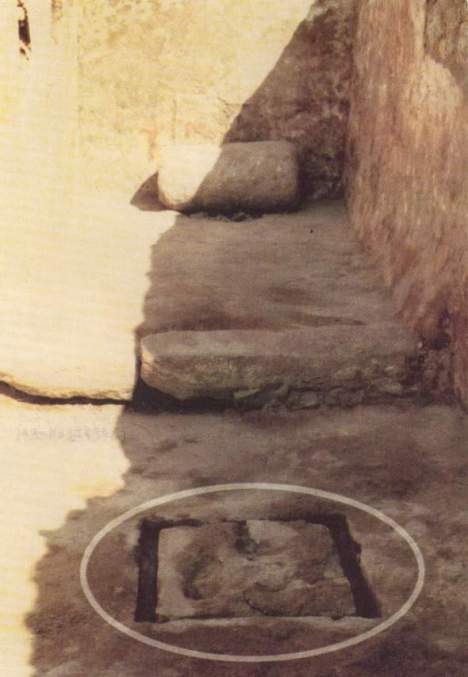
Inilah hasil kongkalingkong penganut Wahabi dan Kerajaan {buatan} asal klan Saud {yg cinta dunia}
Daftar kontradiksi yg aneh:
1.Ziarah kubur haram, tapi nyatanya org Arab kaya ada yg dikafan kantung utk simpan uang?
2.Mempertahankan rumah Nabi dan sahabat haram, namun bikin Istana yg super megah berwarna pink justru dipertahankan?
3.Merayakan maulid dan bershalawat ke Nabi terang2an haram, namun coba aja kalian hina Raja Arab Saudi pasti ditangkap, namun giliran bikin buku dgn kata pengantar memuji Raja justru diperbolehkan?
NB: masih banyak lagi